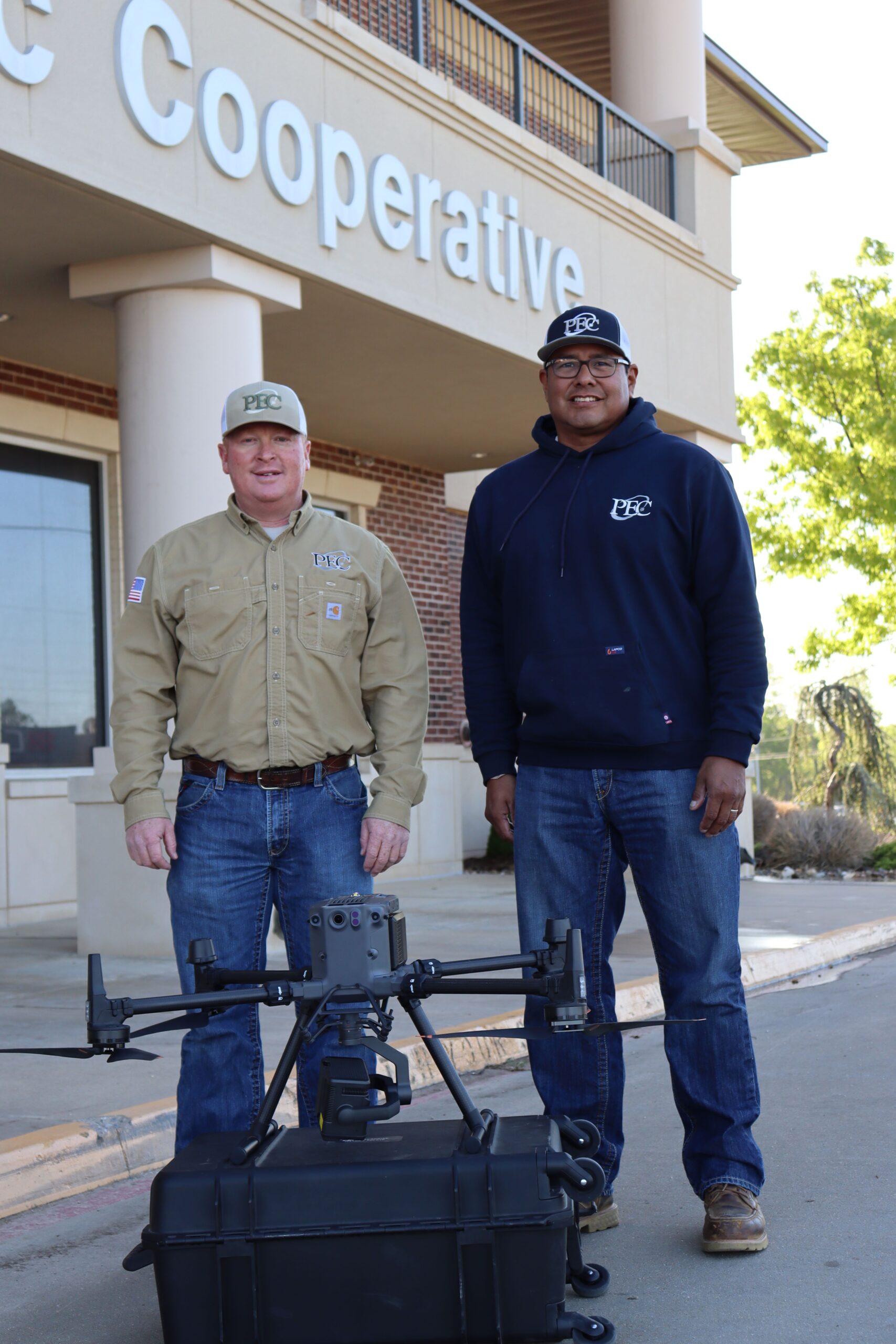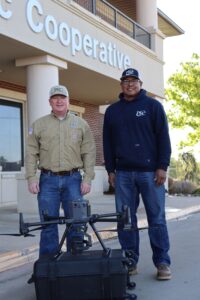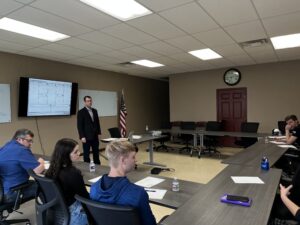
Innovative Heights: How Drones Are Revolutionizing Electrical Service at PEC
April 10, 2024 by Jessika Leatherbury
By: Sunnie Dawn Baker
 While drones can be used for both recreational and business applications, People’s Electric Cooperative (PEC), headquartered in Ada, Oklahoma, is taking drone technology to a new level, harnessing the constantly evolving power of drones for both efficiency and safety. Innovative use of technology enables PEC to not only reduce outage times, but also minimize the potential threat of electrical hazards.
While drones can be used for both recreational and business applications, People’s Electric Cooperative (PEC), headquartered in Ada, Oklahoma, is taking drone technology to a new level, harnessing the constantly evolving power of drones for both efficiency and safety. Innovative use of technology enables PEC to not only reduce outage times, but also minimize the potential threat of electrical hazards.
The cooperative’s first drone encounter happened when PEC’s Director of Substation and Transmission Services Matt Cooley and his Assistant Director Dave McGilbary obtained certification in 2022 and began using the cooperative’s single drone for the completion of annual line inspections. When Cooley and McGilbary recognized the versatility of their new technology, a second drone was added and today, a total of six certified drone pilots are on staff, several of whom received training locally through Pontotoc Technology Center (PTC) in Ada. “As technology has evolved, the flight time of the drones has doubled,” Cooley explains. “And the drone’s camera capabilities have grown as well.”
PEC currently maintains over 5,000 miles of distribution and transmission lines alongside south-central Oklahoma’s winding dirt roads, highways, rivers, and ravines before arriving to local neighborhoods and businesses, making line inspections and maintenance a complex task. When storms occur, wet and muddy terrain can make it nearly impossible for a truck to navigate the countryside. Drones, however, can access locations much more safely and expose trouble spots that may be invisible to the human eye.
“Our line technicians can work more efficiently, and most importantly, overall outage time is reduced for our members,” Cooley explains. “For instance, if an outage occurs, the systems at PEC can provide a broad location of the potential fault. In the past, a line technician would be sent out to the location and would have to drive around and walk through pastures trying to search for the problem area. Now, however, they can send the drone out to inspect the line both visually and with thermal imaging to find the fault much faster. What could have been a long outage in the past, can now be resolved much quicker.”
In addition to helping resolve outages in a timelier manner, drones are now being used for preventative maintenance. McGilbary recalls a particular instance early on in their drone usage while inspecting the lines. “The drone found a hotspot which is a localized area where excessive heat accumulates and increases the risk of electrical fires, equipment damage and electrical system malfunctions. A visual inspection would not have detected this; only thermal imaging could,” McGilbary says.” I am thankful the drone alerted us. Without early detection, repairs would have been costly. Instead, we were able to proactively make the repairs, saving time and potentially thousands of dollars. Best of all, nobody experienced an outage.”
Drones not only help resolve outages quickly and avoid some altogether, but they also provide unparalleled efficiency. Tasks that would have taken hours in the past can now be completed in minutes. Work on PEC’s communication towers is proof that drones are increasing work efficiencies.
“We were inspecting a radio tower that was having some problems and we believed it to have been struck by lightning,” Cooley recalls. “In the past, two employees would have had to physically climb the 195-foot tower to inspect the equipment at the top. With use of the drone, however, both employees were able to stand on the ground and record video to assess the situation. Upon review of the footage, the issue was found to be at the base of the tower and not at the top. This saved time, energy, and avoided the hazardous climb up the radio tower.”
PEC employees prioritize safety as they manage hazardous levels of electrical current and great heights. Some transmission poles may reach 90-feet in height. “Drones give us the capability of being able to inspect from a better vantage point,” McGilbary says. “It is much safer and takes the possibility of human error out of it. You only climb to fix what you need to fix. When there is an outage, the drone allows us to see what we are going into ahead of time.” At PEC’s substations, drones also protect workers from potentially dangerous situations. Drones don’t have the same restrictions as humans; therefore, allowing workers to inspect from afar while providing a closer look and only approaching if necessary.
PEC’s Executive Vice-President and CEO Kevin Wood believes drones are an indispensable tool and praised the innovation he has witnessed at the cooperative. “They continue to look at new ways to utilize this technology,” Wood says. “Our lines have to be inspected once a year, but we envision implementing a procedure so that every mile of line will be inspected by drones to encourage even better reliability and service in the future.” PEC is committed to innovation and forward thinking. As drone technology and capabilities continue to grow, PEC will grow with them, finding new ways to improve their service and reliability while also maintaining safety for the workers who help keep the lights on.
Sign up to receive more news from the Ada Jobs Foundation HERE!
Written by
Jessika Leatherbury
You may also interested in:

Adapt and Overcome: Allison Poe’s Recipe for Resilience and Growth
By: Sunnie Dawn Baker Allison Poe has always followed her feet. She waits for the signs to appear and, once she recognizes them, she travels that path, and has never
Jeff Warren: A Life in Sound, Vision, and Storytelling
By: Sunnie Dawn Baker When Jeff Warren got involved in the Houston music scene as a teenager, he had no clue where his path would lead. Now, nearly thirty years
From Pitch to Progress: ECU's Glass Recycling Program Turns Waste into Opportunity
By: Sunnie Dawn Baker In 2018, Dr. Christine Pappas competed in Ada Jobs Foundation’s Big Pitch Competition by promoting grinding glass bottles into sand. She won the Big Pitch that
The Importance of Customer Discovery: Know Your Audience and Know Your Market
By: Sunnie Dawn Baker Entrepreneurs and small business owners must consider many factors to achieve success, with their target market being one of the most crucial. Sometimes, when people are
What Does Economic Development Do for You? The Significance of the Economic Multiplier
By: Sunnie Dawn Baker People often find the term “economic development” vague and confusing. Understanding how economic development works and benefits the community can be challenging. Though there are many
Helping Entrepreneurs One Workshop at a Time: Lauri Rowe and QuickBooks for Small Businesses
Entrepreneurs tend to be filled with passion and big ideas. They have found a solution to a problem they see in the world, and they barrel ahead, excited for their
Hunter Cook: Technology, Entrepreneurship, and the Written Word
By: Sunnie Dawn Baker Hunter Cook started writing when he was seven years old. At first, he wanted to write comic books, but then he realized he couldn’t draw. He
Empowering Native Artists: FAME App Brings Innovation to First American E-Commerce
By: Sunnie Dawn Baker Entrepreneurs are problem solvers. They are constantly striving for solutions to issues they see in the world or in their own lives. In the case of
Learn, Connect, and Grow: 2025 Workshops for Aspiring and Current Business Owners
By: Sunnie Dawn Baker A new year brings new possibilities, and, at the Ada Jobs Foundation, it also brings a new round of programming and workshops. As the local Economic